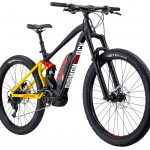How representative is that to real life use with the various Bafang motors (I'm not really familiar with different models etc)? That seems a pretty dreadful power delivery for a pedelec!For completion, here's the power curve for the bbs01, taken from endless sphere
Most powerful eBike for long uphill journeys?
- Thread starter IronLung
- Start date
Just refers to a newer model.What does the second B stand for ???
Sent from my E5823 using Tapatalk
"I have been studying E-bike drive systems for sometime now. I find it amusing that so many people just go by what they read in the brochures. Especially, the Torque ratings!How representative is that to real life use with the various Bafang motors (I'm not really familiar with different models etc)? That seems a pretty dreadful power delivery for a pedelec!
Yet the subjective experience is nowhere near to the corresponding values. To put in crude, vulgar terms, It is like you're courting a girl and you decided to pursue her because this girl has 32B, 36DD.. etc
Torque rating is just one of the parameters and how the overall system is designed is much more important than one single parameter. The algorithm, controller design, power draw etc matter more than just "Torque". A system could have more torque but at what expense? power? less speed?
Bosch - 60Nm and now upped to 70Nm.
Derby Impulse 2.0 - 80Nm (newer RS versions)
TranzX mid drive - 73Nm
BBS-02 - 120Nm
M1 Pin Drive - 120Nm
Dapu - 40Nm
Currie electro drive - 42Nm
Stromer SYNO drive - 35Nm
I could go on..."
...and he does go on
"Out of all mid-drives I have tested only two systems stand out in terms of Torque ( BBS-02 and M1 Pin dirve), rest have been very subdued experience."
See below links. Oldsish article but perhaps still relevant here?
https://electricbikereview.com/forum/threads/torque-rating-on-e-bikes-marketing-gimmick.2467/
https://electricbikereview.com/forum/threads/motor-torque-specs-minefield.3353/
Not now, but back then..." It is like you're courting a girl and you decided to pursue her because this girl has 32B, 36DD.. etc
I have only used 2 (CD) systems. The Yamaha on mine and Bosch CX on bike bought for wife.
CX probably feels to have more torque but performance on hills seems identical ( imho)
To my mind its essential ebike provides adequate but no more power. An architect friend of mine , who is responsible for some quite famous structures, often says
" Any fool can design a bridge...you need an architect to just build a bridge"
Too much power/ torque simply reduces your range...or makes bike heavier...
For our use Haibikes are perfect. Out yesterday wife pedalled up long steep hills in Derbyshire without even a comment. Perfect. They really are that good.
Sixteen mile ride, couple of very steep ( 20%) short inclines, one long fairly steep , rest easy but both bikes only used around 35%. ( I was in standard, wife in high)
CX probably feels to have more torque but performance on hills seems identical ( imho)
To my mind its essential ebike provides adequate but no more power. An architect friend of mine , who is responsible for some quite famous structures, often says
" Any fool can design a bridge...you need an architect to just build a bridge"
Too much power/ torque simply reduces your range...or makes bike heavier...
For our use Haibikes are perfect. Out yesterday wife pedalled up long steep hills in Derbyshire without even a comment. Perfect. They really are that good.
Sixteen mile ride, couple of very steep ( 20%) short inclines, one long fairly steep , rest easy but both bikes only used around 35%. ( I was in standard, wife in high)
Last edited:
D
Deleted member 4366
Guest
Torque comes from the gearing on a crank-drive bike. All the differences or similarities that people report are more likely just a result of their different or similar gearing, nothing to do with the motor power.
For the motors, it's simple: The more current you run, the more power you get. There's no magic formula in the motor that makes it able to make more with less. As far as I can figure, all the more powerful CDs are running something like 18 to 20 amps. The more current you run, the faster your battery goes down.
For the motors, it's simple: The more current you run, the more power you get. There's no magic formula in the motor that makes it able to make more with less. As far as I can figure, all the more powerful CDs are running something like 18 to 20 amps. The more current you run, the faster your battery goes down.
Going back to that graphic that was posted showing the various power v RMP curves, if we assume for a moment that those figures are indeed representative of what happens, my question is - how?For the motors, it's simple: The more current you run, the more power you get. There's no magic formula in the motor that makes it able to make more with less.
How come the Yamaha has the very sharp falloff (which people are saying is what is typical), yet the others do not?
d8veh asked the same question re. the CX plot suggests it still gives nearly 400W at 120 RPM while their website says it should not assist.How come the Yamaha has the very sharp falloff (which people are saying is what is typical), yet the others do not?
I take these graphs with a pinch of salt when I cannot find a second source.
There is good engineering and bad engineering but power from the motor depends very much how much you open the throttle.
I quote the guy who posted it on pedelecforum.de
https://www.pedelecforum.de/forum/index.php?threads/bosch-yamaha-brose-shimano-motorkennlinien-im-direkten-vergleich.47822/Hello everybody,
By chance I found on Facebook a photo from a training presentation, which I think is so interesting that I want to show it here:
1973ertommy's comments are an interesting observation.I quote the guy who posted it on pedelecforum.de
https://www.pedelecforum.de/forum/index.php?threads/bosch-yamaha-brose-shimano-motorkennlinien-im-direkten-vergleich.47822/
Admittedly translated by Google, he writes
"My brother-in-law with his CX blows me on the mountain but in terms of range I lie back in front"
I'm not going riding with them ta very much
Sent from my E5823 using Tapatalk
D
Deleted member 4366
Guest
1. The graphs are wrong if you take them the way people are interpreting them. Maybe if you examined the source where they were taken from, there might be an explanation that shows that they're not what we think they are, otherwise it's just marketing BS.Going back to that graphic that was posted showing the various power v RMP curves, if we assume for a moment that those figures are indeed representative of what happens, my question is - how?
How come the Yamaha has the very sharp falloff (which people are saying is what is typical), yet the others do not?
2. All the motors have a sharp fall off. You can't change that. It's just the way the physics works. The only way you could change it would be to make the motor run much faster, then limit it's power. If you did that, you'd have low efficiency at low speed, which would be bad all-round.
"Make the motor run much faster". Does this effectively mean designing a motor to run at a fast speed at a given voltage, (or increasing the voltage to a given motor design)2. All the motors have a sharp fall off. You can't change that. It's just the way the physics works. The only way you could change it would be to make the motor run much faster, then limit it's power. If you did that, you'd have low efficiency at low speed, which would be bad all-round.
"limit its power" - back to the voltage thing again - so if you had an inherently faster running motor, but ran it at a lower than 'normal' voltage, you would shift the (shape of the) power curve down the RPM range ?
D
Deleted member 4366
Guest
To answer your question, if you feed a Bosch motor unlimited current and put it on a dynamometer to get it's torque and power curve. It's torque curve would be a straight line from some level at zero rpm to zero torque at maximum rpm. The power curve will curve up (reducing slope) to maximum power at about 70% of maximum rpm and then ramp down to zero at maximum rpm. According to Bosch, max RPM is 120 for the CX motor. The controller can make any shape it wants to each of those curves by limiting the power as long as the line is below the unhindered ones. It can't add anything.
If you increase the voltage, the motor has the capability to run faster in proportion, but the efficiency in the lower RPM will suffer a lot when you give full power. The higher the speed you allow, the more over-heating you get at low speed. As an e-bike designer, you need to design the motor to work in the range that the user operates. The controller can't increase the voltage. It's the battery that provides it.
People have tried over-volting their Bafang crank-drives. It's OK if you don't want to pedal, just use the throttle like a motorbike, but it doesn't work if you want to pedal because the crank spins too fast to keep up with it.
If you increase the voltage, the motor has the capability to run faster in proportion, but the efficiency in the lower RPM will suffer a lot when you give full power. The higher the speed you allow, the more over-heating you get at low speed. As an e-bike designer, you need to design the motor to work in the range that the user operates. The controller can't increase the voltage. It's the battery that provides it.
People have tried over-volting their Bafang crank-drives. It's OK if you don't want to pedal, just use the throttle like a motorbike, but it doesn't work if you want to pedal because the crank spins too fast to keep up with it.
Wise words as always Sir.To answer your question, if you feed a Bosch motor unlimited current and put it on a dynamometer to get it's torque and power curve. It's torque curve would be a straight line from some level at zero rpm to zero torque at maximum rpm. The power curve will curve up (reducing slope) to maximum power at about 70% of maximum rpm and then ramp down to zero at maximum rpm. According to Bosch, max RPM is 120 for the CX motor. The controller can make any shape it wants to each of those curves by limiting the power as long as the line is below the unhindered ones. It can't add anything.
If you increase the voltage, the motor has the capability to run faster in proportion, but the efficiency in the lower RPM will suffer a lot when you give full power. The higher the speed you allow, the more over-heating you get at low speed. As an e-bike designer, you need to design the motor to work in the range that the user operates. The controller can't increase the voltage. It's the battery that provides it.
People have tried over-volting their Bafang crank-drives. It's OK if you don't want to pedal, just use the throttle like a motorbike, but it doesn't work if you want to pedal because the crank spins too fast to keep up with it.
Yes, I understand it can't add more power.The controller can make any shape it wants to each of those curves by limiting the power as long as the line is below the unhindered ones. It can't add anything.
However, lets perform a thought experiment. If you took a motor that was capable of a fairly high RPM speed at a nominal 36V, and you paired it with a controller that was capable of pushing out a pretty high current if the control algorithm wanted to, but the software was able to intelligently alter power/voltage delivery, could you reproduce a power delivery graph like the one we've been looking at from the german site that shows a less 'peaky' delivery for the Bosch motor?
changing the voltage at low loss is the job for a switch mode PSU, with our current state of electronic designs, it won't pass EN15194 on electromagnetic emission limit.the software was able to intelligently alter power/voltage delivery,
You are better off using a mechanical gearbox or derailleur.
But all the information I've been seeing recently, indicates that the ebike controllers already perform the power control by pulse width modulating MOSFETS that are driven in switching mode. That in effect is what a switched mode power supply does.changing the voltage at low loss is the job for a switch mode PSU, with our current state of electronic designs, it won't pass EN15194 on electromagnetic emission limit.
??
D
Deleted member 4366
Guest
In a word, no, not in a practical way for a legal ebike. Maybe Harry Potter could if he waved his wand in the right way and said the right words.Yes, I understand it can't add more power.
However, lets perform a thought experiment. If you took a motor that was capable of a fairly high RPM speed at a nominal 36V, and you paired it with a controller that was capable of pushing out a pretty high current if the control algorithm wanted to, but the software was able to intelligently alter power/voltage delivery, could you reproduce a power delivery graph like the one we've been looking at from the german site that shows a less 'peaky' delivery for the Bosch motor?
Related Articles
-
 Bosch eBike announce new motors, batteries & anti-tuning software
Bosch eBike announce new motors, batteries & anti-tuning software- Started by: Pedelecs
-
 Member reviews: 2017 KTM Fogo 271
Member reviews: 2017 KTM Fogo 271- Started by: EddiePJ
-
 2018 Giant – E+1 SX Pro Review
2018 Giant – E+1 SX Pro Review- Started by: EddiePJ
-
 DiamondBack Ranger debuts in UK
DiamondBack Ranger debuts in UK- Started by:


